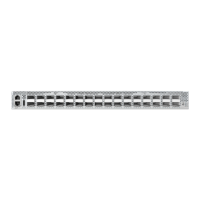C
HAPTER
17
| General IP Routing
Equal-cost Multipath Routing
– 451 –
manually configured in the static routing table, or equal-cost multipaths
dynamically generated by the Open Shortest Path Algorithm (OSPF). In
other words, it uses either static or OSPF entries, not both. Normal unicast
routing simply selects the path to the destination that has the lowest cost.
Multipath routing still selects the path with the lowest cost, but can forward
traffic over multiple paths if they all have the same lowest cost. ECMP is
enabled by default on the switch. If there is only one lowest cost path
toward the destination, this path will be used to forward all traffic. If there
is more than one lowest-cost path configured in the static routing table
(see "Configuring Static Routes" on page 447), or dynamically generated
by OSPFv2 (see "Configuring the Open Shortest Path First Protocol (Version
2)" on page 502), then up to 8 paths with the same lowest cost can be
used to forward traffic to the destination.
CLI REFERENCES
◆ "maximum-paths" on page 1021
COMMAND USAGE
◆ ECMP only selects paths of the same protocol type. It cannot be applied
to both static paths and dynamic paths at the same time for the same
destination. If both static and dynamic paths have the same lowest
cost, the static paths have precedence over dynamic paths.
◆ Each path toward the same destination with equal-cost takes up one
entry in the routing table to record routing information. In other words,
a route with 8 paths will take up 8 entries.
◆ The routing table can only have up to 8 equal-cost multipaths for static
routing and 8 for dynamic routing for a common destination. However,
the system supports up to 256 total ECMP entries in ASIC for fast
switching, with any additional entries handled by software routing.
◆ When there are multiple paths toward the same destination with equal-
cost, the system chooses one of these paths to forward each packet
toward the destination by applying a load-splitting algorithm.
A hash value is calculated based upon the source and destination IP
fields of each packet as an indirect index to one of the multiple paths.
Because the hash algorithm is calculated based upon the packet header
information which can identify specific traffic flows, this technique
minimizes the number of times a path is changed for individual flows.
In general, path changes for individual flows will only occur when a
path is added or removed from the multipath group.
PARAMETERS
These parameters are displayed in the web interface:
◆ ECMP Number – Sets the maximum number of equal-cost paths to the
same destination that can be installed in the routing table.
(Range: 1-8; Default: 4)

